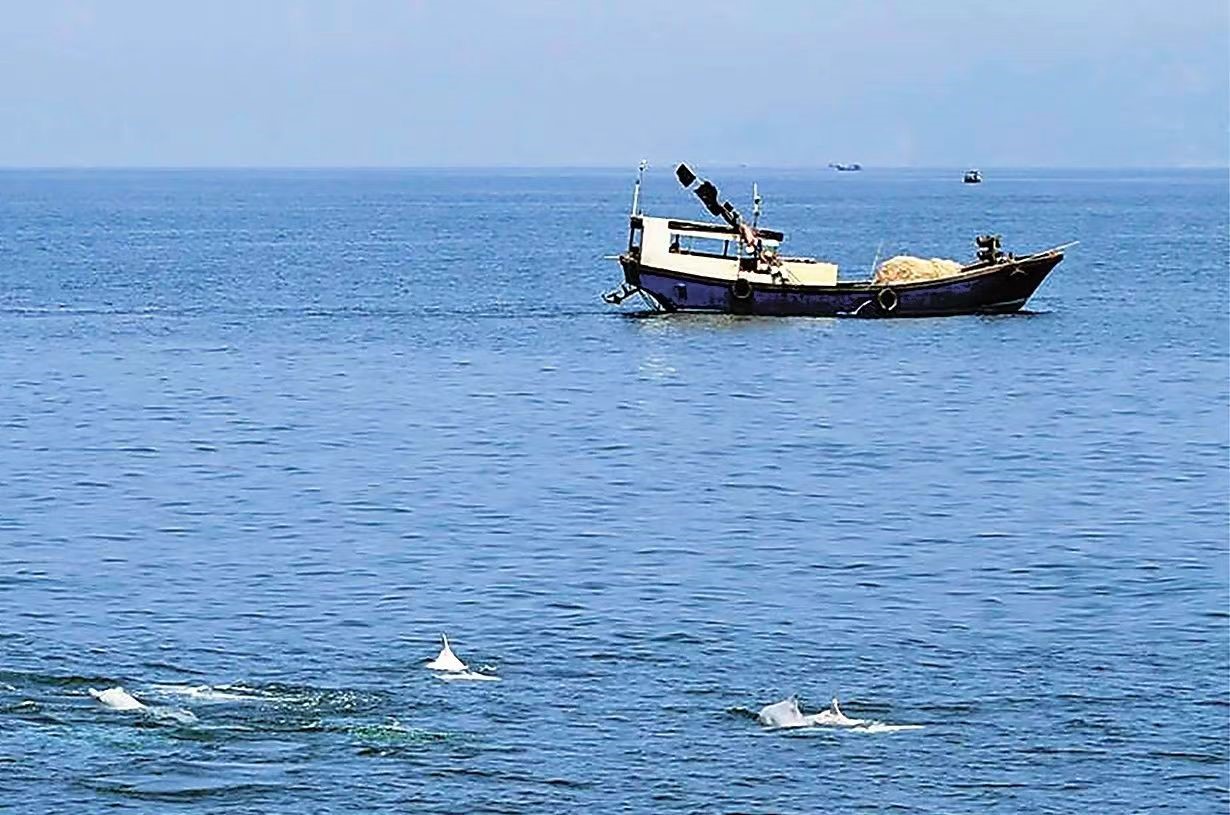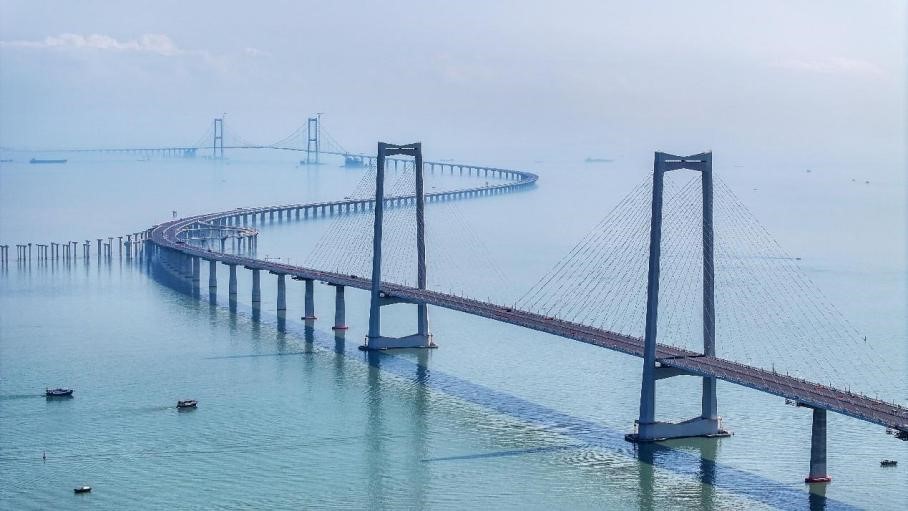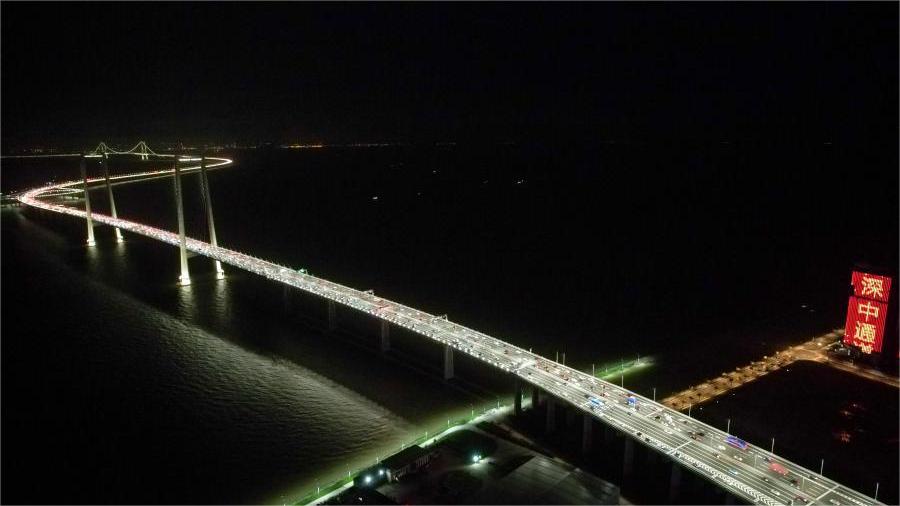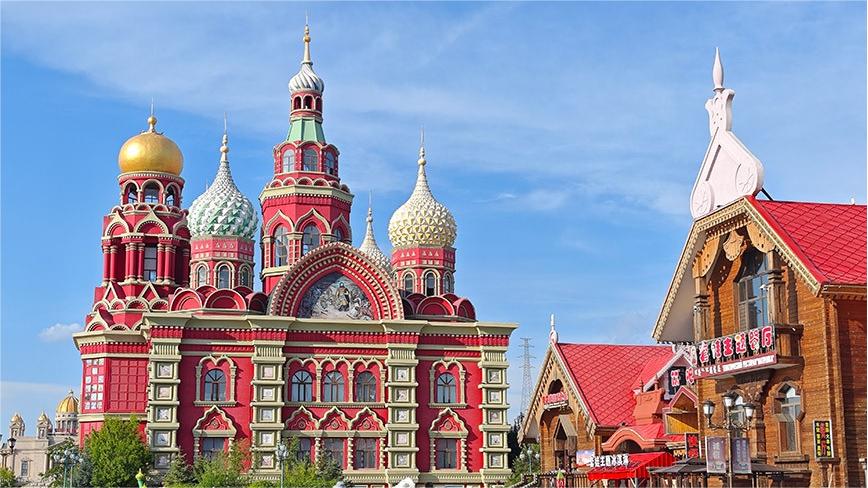Workers safeguard Chinese white dolphin habitat during Shenzhen-Zhongshan link construction
"Look! Chinese white dolphins!"
A sudden exclamation rang out at a construction site of the west artificial island of the Shenzhen-Zhongshan link, a core transportation hub project in the Guangdong-Hong Kong-Macao Greater Bay Area.

Chinese white dolphins are seen in the construction area of the Shenzhen-Zhongshan link in south China's Guangdong province. (Photo/Lin Wenqi)
Workers at the construction site were thrilled to see a group of Chinese white dolphins in the Lingdingyang waters of the Pearl River Estuary. The dolphins dived in and out the water, creating a captivating spectacle alongside the Shenzhen-Zhongshan link.
Connecting the eastern and western banks of the Pearl River, the Shenzhen-Zhongshan link is a cross-sea cluster project that includes bridges, artificial islands, tunnels, and submerged connection. The waters it traverses are part of the Pearl River Estuary Chinese White Dolphin National Nature Reserve, which covers an area of about 460 square kilometers and is home to a significant population of Chinese white dolphins.
The massive engineering project presents significant challenges for the conservation of Chinese white dolphins.
The design of the project incorporated ecological protection from its inception, integrating it into construction, shipping, and environmental monitoring, according to Xu Guoping, chief tunnel designer of the Shenzhen-Zhongshan link from China Communications Construction Company (CCCC) Highway Consultants Co., Ltd.
Through innovations in technologies, procedures and management, the project aims to better protect Chinese white dolphins, which are under first-class protection in China, said Xu.
Viewed from the air, the west artificial island of the Shenzhen-Zhongshan link resembles a giant bird in flight.
"Building an island of about 137,000 square meters, equivalent to 19 standard football fields, on the vast sea would disrupt the Chinese white dolphins' habitat if using traditional construction methods," said Liu Haobin, deputy general manager of the Shenzhen-Zhongshan link project department from CCCC First Harbor Engineering Co., Ltd.
The construction team independently developed a device consisting of 12 synchronized hydraulic vibratory hammers, which helped drive 57 massive steel cylinders into the seabed in just four and a half months, setting a new record for rapid island construction. This achievement also helped minimize the impact on the marine environment and the white dolphins, Liu noted.
For the workers of the project, the protection of Chinese white dolphins has become a "sprint" and a "relay race" during the seven-year construction period.
The key project of the Shenzhen-Zhongshan link, a 5,035-meter-long underwater immersed tube tunnel, involved connecting 32 sections of immersed tubes and a final point. Transporting the immersed tubes from the factory to the installation area required navigating a 50-kilometer-long sea route with 7 channel changes.

Photo shows the Shenzhen-Zhongshan link. (People's Daily Online/Chen Zhiqiang)
To transport the immersed tubes more quickly to their designated positions, the construction team proposed a creative solution - building a ship for both transportation and installation.
"Compared to traditional towing methods, the ship can reduce dredging by over 10 million cubic meters and emissions by about 1 million cubic meters, effectively preserving the marine environment where the dolphins reside," said Ning Jinjin, deputy general engineer of the project from CCCC First Harbor Engineering Co., Ltd.
The undersea tunnel of the Shenzhen-Zhongshan link, spanning approximately 6.8 kilometers, is the world's longest and widest steel-shelled concrete immersed tunnel. Precise placement of each section of the tunnel was crucial.
To better protect the dolphins, the construction team developed a patented anti-pollution system for cement mixing vessels. This system creates two pollution barriers, thus preventing the sewage generated from piling from entering the sea and polluting the dolphins' habitat.
The installation of the 32 sections of immersed tubes took a full three years. Apart from technological advancements, the construction team also developed a Chinese white dolphin protection management manual.
This manual assigns direct responsibility for dolphin protection to the captain of each construction vessel and appoints dedicated dolphin observers to monitor their activities day and night.
"Attention, all vessels! Crew members must not throw any garbage into the sea. Let's stay vigilant until the very end!" Liao Wenlong, a project manager from CCCC Second Harbor Engineering Co., Ltd., reminded workers over the radio at the construction site of the Shenzhen-Zhongshan bridge, where temporary facilities were being dismantled. The sea bridge is a key part of the Shenzhen-Zhongshan link, with the world's highest navigation clearance.
To minimize the impact on the marine environment, the construction team implements green practices for handling domestic and production waste.
"All vehicles must wear protective clothing to minimize dust generation during sand and gravel transport. Tank trucks are cleaned and the liquid on them is absorbed by absorbent pads when entering and leaving mixing stations," Liao recalled. He added that dust collectors have been installed atop storage tanks for powdered materials.
Strengthened management and regular waste transfer were key. "We strictly implemented waste sorting and scheduled regular transfers for processing," Liao explained. After five years, the bridge has completed all construction phases including pile foundations, bridge towers, and steel box girders. "We are leaving behind only a bridge, not our waste," said Liao.
Photos
Related Stories
- China's latest mega cross-sea link opens to traffic
- President calls for full utilization of new cross-sea link
- First cross-broader electric coach linking Hong Kong and Shenzhen starts operation
- Foreign investment in Shenzhen's Qianhai exceeds 40 bln USD
- China's megacity Shenzhen enjoys fruits of ecological conservation
Copyright © 2024 People's Daily Online. All Rights Reserved.









